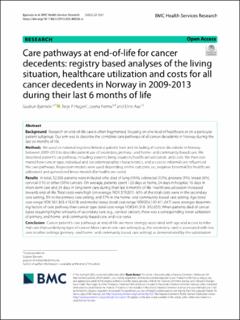| dc.description.abstract | Background
Research on end-of-life care is often fragmented, focusing on one level of healthcare or on a particular patient subgroup. Our aim was to describe the complete care pathways of all cancer decedents in Norway during the last six months of life.
Methods
We used six national registries linked at patient level and including all cancer decedents in Norway between 2009-2013 to describe patient use of secondary, primary-, and home- and community-based care. We described patient’s car pathway, including patients living situation, healthcare utilization, and costs. We then estimated how cancer type, individual and sociodemographic characteristics, and access to informal care influenced the care pathways. Regression models were used depending on the outcome, i.e., negative binomial (for healthcare utilization) and generalized linear models (for healthcare costs).
Results
In total, 52,926 patients were included who died of lung (16%), colorectal (12%), prostate (9%), breast (6%), cervical (1%) or other (56%) cancers. On average, patients spent 123 days at home, 24 days in hospital, 16 days in short-term care and 24 days in long-term care during their last 6 months of life. Healthcare utilization increased towards end-of-life. Total costs were high (on average, NOK 379,801). 60% of the total costs were in the secondary care setting, 3% in the primary care setting, and 37% in the home- and community-based care setting. Age (total cost-range NOK 361,363-418,618) and marital status (total cost-range NOK354,100-411,047) were stronger determining factors of care pathway than cancer type (total cost-range NOK341,318- 392,655). When patients died of cancer types requiring higher amounts of secondary care (e.g., cervical cancer), there was a corresponding lower utilization of primary, and home- and community-based care, and vice versa.
Conclusion
Cancer patient’s care pathways at end-of-life are more strongly associated with age and access to informal care than underlying type of cancer. More care in one care setting (e.g., the secondary care) is associated with less care in other settings (primary- and home- and community based care setting) as demonstrated by the substitution between the different levels of care in this study. Care at end-of-life should therefore not be evaluated in one healthcare level alone since this might bias results and lead to suboptimal priorities. | en_US |

